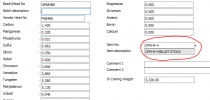AKS is no longer selling CPM M4 and now has Zap. The big difference is that the Zap has .55 Si. Has anyone found there to be a difference with the heat treatment? I ordered a couple of pieces of thicker stock for the Charpy test but for the moment I'm trying to do a chef. While I'm at it how hard can I run it on a chef's knife before it starts getting chippy? Should I try high temper or low temper first? I did M2 at 2200 for 5 minutes with a 400 temper and cryo and really liked it.
You are using an out of date browser. It may not display this or other websites correctly.
You should upgrade or use an alternative browser.
You should upgrade or use an alternative browser.
Zap PM M4 vs CPM M4 heat treatment?
- Thread starter Storm W
- Start date
Larrin
Knifemaker / Craftsman / Service Provider
- Joined
- Jan 17, 2004
- Messages
- 4,847
Crucible doesn't list the manganese or silicon content for most of their tool steels, but they are present in amounts of at least 0.3% for all of the steels that I have seen values for. In the patent for 3V, the composition of CPM M4 is listed with 0.56% silicon. https://patentimages.storage.googleapis.com/36/0f/e3/6aa98edaa4eec4/US5830287.pdf
Thanks. I assume there is no need to run both brands then? I ordered a thicker piece of the Zap to test it.Crucible doesn't list the manganese or silicon content for most of their tool steels, but they are present in amounts of at least 0.3% for all of the steels that I have seen values for. In the patent for 3V, the composition of CPM M4 is listed with 0.56% silicon. https://patentimages.storage.googleapis.com/36/0f/e3/6aa98edaa4eec4/US5830287.pdf
Did you think it was worth testing a prequench on the M4 or M2? I have enough material for at least 6 samples if there is any thing that would be interesting to try let me know.
Larrin
Knifemaker / Craftsman / Service Provider
- Joined
- Jan 17, 2004
- Messages
- 4,847
The original prequench research was done on M2 so I think definitely.Thanks. I assume there is no need to run both brands then? I ordered a thicker piece of the Zap to test it.
Did you think it was worth testing a prequench on the M4 or M2? I have enough material for at least 6 samples if there is any thing that would be interesting to try let me know.
What temp for the prequench. My only reference point are some recipes that people credit your dad for like AEB-L. I would think that M steels would use a different temp.The original prequench research was done on M2 so I think definitely.
Larrin
Knifemaker / Craftsman / Service Provider
- Joined
- Jan 17, 2004
- Messages
- 4,847
It's certainly possible that a different temperature would be optimal in M2 vs AEB-L. In the original research they found that a relatively wide range of temperatures were acceptable for achieving grain refinement (1600-1900°F). On the other hand, grain refinement is not always the same as toughness improvement. The optimal prequench temperature was 1750°F with AEB-L so that is probably a useful starting point.
I will start at 1750 and do 2 or 3 up to 1900. ThanksIt's certainly possible that a different temperature would be optimal in M2 vs AEB-L. In the original research they found that a relatively wide range of temperatures were acceptable for achieving grain refinement (1600-1900°F). On the other hand, grain refinement is not always the same as toughness improvement. The optimal prequench temperature was 1750°F with AEB-L so that is probably a useful starting point.
- Joined
- Jun 15, 2009
- Messages
- 185
Crucible does report Si and Mn on the certs and we enter it into our system. These numbers will be on any cert if you buy from us or an authorized distributor.
Below is an example of the information we enter when we receive a heat. The Batch/Heat No field is the heat number we assign to the batch. The vendor heat number is from the mill. We insert an "N" in front of their number so we can tell if it is material we bought from Crucible or a heat that we are converting for a customer like Zapp, Latrobe or Crucible. You can always check with us for a chemistry if you have a heat number and we owned it at one time. Our heat numbers always start with an "N". If it's CPM the next letter will be "R" or "P".

Below is an example of the information we enter when we receive a heat. The Batch/Heat No field is the heat number we assign to the batch. The vendor heat number is from the mill. We insert an "N" in front of their number so we can tell if it is material we bought from Crucible or a heat that we are converting for a customer like Zapp, Latrobe or Crucible. You can always check with us for a chemistry if you have a heat number and we owned it at one time. Our heat numbers always start with an "N". If it's CPM the next letter will be "R" or "P".

